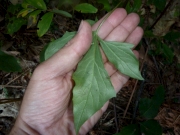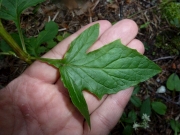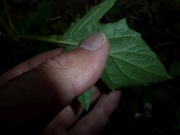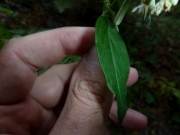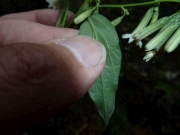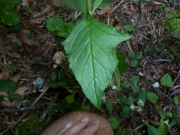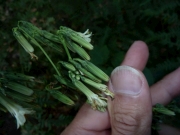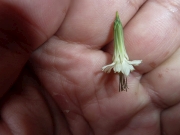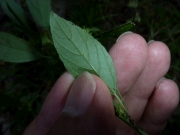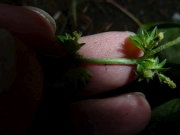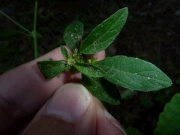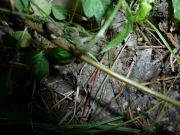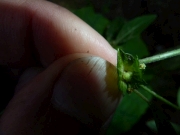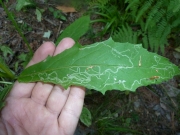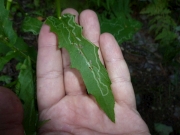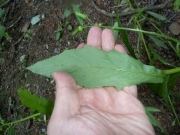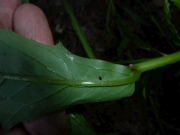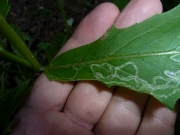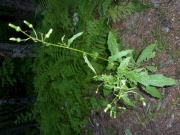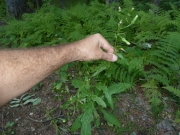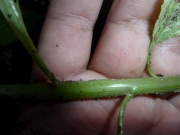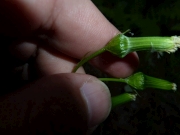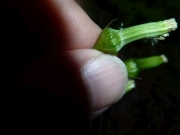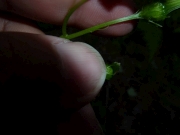Transformational Gardening
August 2011 Foraging Experiences
(Back to:
July 2011 Foraging Experiences)
(Forward to:
September 2011 Foraging Experiences)
August 3, 2011
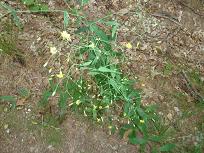
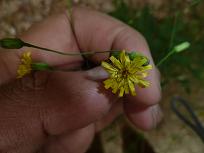 The flowers of this plant looked just like Hawkweed flowers. There are a handful
of Hawkweeds in New Hampshire that have leaves growing up the stem:
The flowers of this plant looked just like Hawkweed flowers. There are a handful
of Hawkweeds in New Hampshire that have leaves growing up the stem:
- Allegheny Hawkweed (Hieracium paniculatum)
- Kalm’s Hawkweed (Canada Hawkweed) (Hieracium kalmii)
- Common Hawkweed (Hieracium lachenalii)
- Maryland Hawkweed (Hieracium marianum)
- Robinson’s Hawkweed (Hieracium robinsonii)
- Rough Hawkweed (Hieracium scabrum)
- Narrowleaf Hawkweed (Hieracium umbellatum)
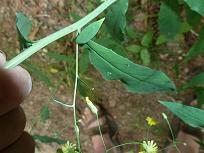
 Narrowleaf Hawkweed has a thinner leaf width (up to 1-1/2 inches wide) and
the penduncles (flower stems) and plant stem have significant hairs. Rough
Hawkweed has a very bristly/hairy leaf margin, hairy stems and long
black hairs on the stem below the flowers. Robinson’s Hawkweed has leaves with
slightly larger and more regular teeth that make is look a bit like a wide-leaved
Fall Dandelion (Leontodon autumnalis). In addition, Robinson’s Hawkweed
has a hairy penduncle (not black hairs like Rough Hawkweed). Maryland Hawkweed
has mostly basal leaves with two to several stem leaves.
Narrowleaf Hawkweed has a thinner leaf width (up to 1-1/2 inches wide) and
the penduncles (flower stems) and plant stem have significant hairs. Rough
Hawkweed has a very bristly/hairy leaf margin, hairy stems and long
black hairs on the stem below the flowers. Robinson’s Hawkweed has leaves with
slightly larger and more regular teeth that make is look a bit like a wide-leaved
Fall Dandelion (Leontodon autumnalis). In addition, Robinson’s Hawkweed
has a hairy penduncle (not black hairs like Rough Hawkweed). Maryland Hawkweed
has mostly basal leaves with two to several stem leaves.
Kalm’s Hawkweed has a lower stem and underside of leaves with long
hairs. In most pictures, it appears that the flower stem grows a foot or more
above the stem leaves and the flower stems do not droop much. The Kalm’s
Hawkweed leaves look a bit like my pictures except they are shorter and wider
(proportionally).
Common Hawkweed has mostly larger basal leaves with 4-7 sessile stem leaves. The 2-1/2
foot tall stem is topped by 4-12 yellow flowers in a round-topped cluster. Flower
heads have white hairs around the base (like Robinson’s Hawkweed). The
leaves of Common Hawkweed have larger teeth than this plant.
This left me with a description of Allegheny Hawkweed that closely matched the
pictures and an
online image from florafinder.com that looks just like this plant:
Largely solitary stems (up to 3 feet tall) with stem leaves up into the inflorescene
and few to no basal leaves. The stem is mostly hairless (ocassional hairs). The leaves
are papery thin and have an irregularly-tooth margin (few teeth). The underside of the
leaves are slightly whitened. The inflorescense at the top contains up to 20 flowers
on thin, flexible and mostly hairless peduncles (flower stalks). The flowers are up
to 1.5 cm (3/5 inches) wide, while those of other hawkweeds can be up to 1 inch wide.
The smaller flowering heads, slender and flexible flower stalks and papery thin and mostly
hairless leaves are distinguishing characteristics.
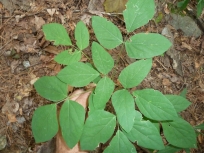
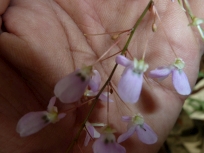
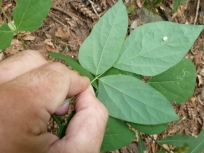
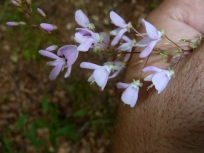
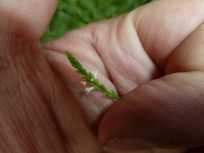
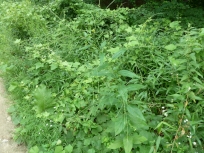
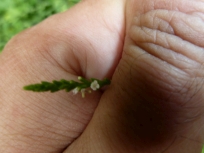
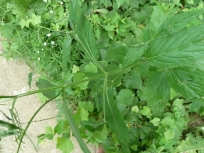
August 4, 2011
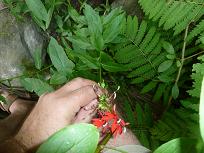
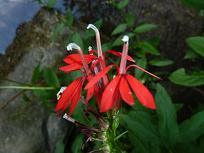 In September, 2010 I found and took
pictures of Cardinalflower. But it was not a real “find” of the plant
since it was located at the Audobon Society and I believe it had been planted by
the staff. Today, however, I found it in the wild by going slightly off-trail
over some rocks next to a creek.
In September, 2010 I found and took
pictures of Cardinalflower. But it was not a real “find” of the plant
since it was located at the Audobon Society and I believe it had been planted by
the staff. Today, however, I found it in the wild by going slightly off-trail
over some rocks next to a creek.
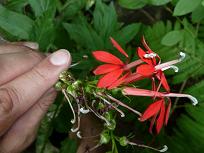
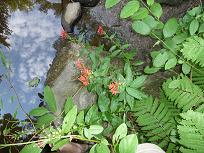 Cardinalflower is in the genus, Lobelia. Lobelia has been used for many
years by naturopaths to treat asthma, smoking addiction and externally to treat
muscle spasm. An overdose can cause nausea and vomiting, so it is best to rely
on the help of a professional herbalist or become knowledgable about proper dosing
when using Lobelia.
Cardinalflower is in the genus, Lobelia. Lobelia has been used for many
years by naturopaths to treat asthma, smoking addiction and externally to treat
muscle spasm. An overdose can cause nausea and vomiting, so it is best to rely
on the help of a professional herbalist or become knowledgable about proper dosing
when using Lobelia.
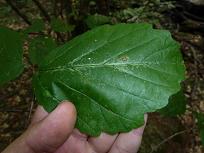
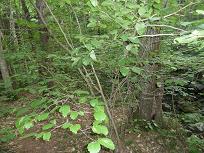 Right across the main path from the Cardinalflower (Lobelia cardinalis)
I spotted American Witchhazel, a shrub I learned about in the recent
Healing with Plants, Fungi and Lichen class.
Right across the main path from the Cardinalflower (Lobelia cardinalis)
I spotted American Witchhazel, a shrub I learned about in the recent
Healing with Plants, Fungi and Lichen class.
It is a shrub with simple, alternate leaves that have crenate (rounded-tooth) margins
and an asymetrical leaf base (as can be seen from the pictures). It has a dense cluster
of stems at its base. The bark is light brown. The flowers are usually yellow (sometimes
orange or redish) and have four ribbon-shaped petals.
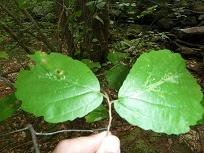
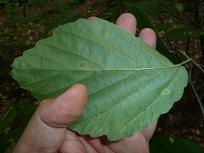 Tea can be made with the leaves (infusion) or the branchlets and inner bark (decoction).
It is valuable astringent. An ointment can be applied externally to treat
hemorrhoids. The tincture can be applied on sprains, bruises, wounds and the powder
mixed with honey and water can be applied to burns, abrasions and crushed toes and
fingers. The tea can be applied externally as well to treat sore muscles/backs, bruises,
swellings, cuts, insect bites, poison ivy, sunburn and varicose veins. Steam derived
from decocting stems can be used to treat sore muscles.
Tea can be made with the leaves (infusion) or the branchlets and inner bark (decoction).
It is valuable astringent. An ointment can be applied externally to treat
hemorrhoids. The tincture can be applied on sprains, bruises, wounds and the powder
mixed with honey and water can be applied to burns, abrasions and crushed toes and
fingers. The tea can be applied externally as well to treat sore muscles/backs, bruises,
swellings, cuts, insect bites, poison ivy, sunburn and varicose veins. Steam derived
from decocting stems can be used to treat sore muscles.
The tea can be used as a gargle for sore throat and taken internally for diarrhea,
hemorrhages, mucus discharge, prolapsed internal organs and excessive menses. I’ll
be collecting Witchhazel for tea, tincture and powder next time I go out.
August 5, 2011
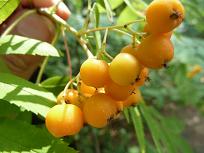
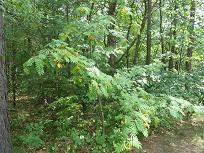
One of the ways to tell the difference between European Mountain Ash (Sorbus
aucuparia), American Mountain Ash (Sorbus americana) and Northern Mountain
Ash (Sorbus decora) is that the winter buds of the European Mountain Ash
are densely hairy (long white-gray hairs). The other two species have hairless or
nearly hairless sticky buds that are red or dark purplish-red. You can see very
hairy buds in the images below.
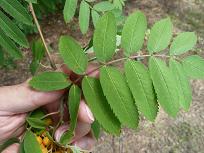
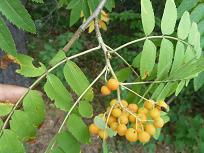
August 6, 2011
Walked quite a bit along swamp, pond, creek and river areas today. Took some
pictures
of a large stand of Common Buttonbush (Cephalanthus occidentalis) plants at the
edge and partially in a pond. On the way back I took some
pictures
of Purple Chokeberry (Aronia prunifolia) which I have only found once before
(and made juice from the berries last year).
Maybe I’ll wade out into the water next time to get a better picture.
There are two subspecies of White Water-Lily:
- Nymphaea odorata Aiton subsp. tuberosa: Leaf stalk with brown and purple stripes.
- Nymphaea odorata Aiton subsp. odorata: Leaf stalk usually unstriped.
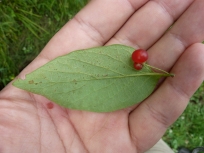
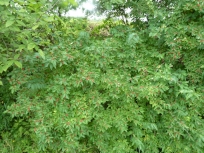 I may not ever be able to easily differentiate the honeysuckles. I will call
this Tatarian Honeysuckle even though I’m not 100% certain. The pictures
fit most of the description of Tatarian Honeysuckle such as glaborous (hairless)
underside of leaves and branchlets. The peduncles (flower/fruit stalks) are
15-25mm long. Dense and twiggy shrub. Pith is white. The only problem is that the
field guides say the leaves are up to 6.5cm long, but some of these leaves are
7.5cm long. Still it does not seem to even come close to fitting the description
of any other Honeysuckles in the area. The following are the Honeysuckles that grow
in New Hampshire and the reason (if any) that this plant is different:
I may not ever be able to easily differentiate the honeysuckles. I will call
this Tatarian Honeysuckle even though I’m not 100% certain. The pictures
fit most of the description of Tatarian Honeysuckle such as glaborous (hairless)
underside of leaves and branchlets. The peduncles (flower/fruit stalks) are
15-25mm long. Dense and twiggy shrub. Pith is white. The only problem is that the
field guides say the leaves are up to 6.5cm long, but some of these leaves are
7.5cm long. Still it does not seem to even come close to fitting the description
of any other Honeysuckles in the area. The following are the Honeysuckles that grow
in New Hampshire and the reason (if any) that this plant is different:
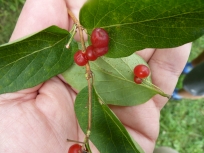
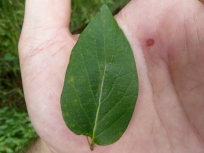
- Lonicera canadensis (American Fly Honeysuckle): Leaf margin has obvious hairs, fruit
has more of a cone/triangular shape with each pair facing away from each other.
- Lonicera villosa (Mountain Fly Honeysuckle): Leaves sessile (no petiole/leaf stem).
- Lonicera dioica (Limber Honeysuckle: Leaves sessile (sometimes perfoliate), fruit often
together in a cluster of six berries. Note: Perfoliate means that the leaves that are
have no stalks, clasp the stem making it appear that the stem pierces the leaves.
- Lonicera japonica (Japanese Honeysuckle): Grows as a woody vine. Black fruit. Broad,
evergreen leaves with hairs beneath.
- Lonicera korolkowii (Blueleaf Honeysuckle): Underside of leaves is blue-green
in Spring (turns grayish at maturity) and pubescent (hairy).
- Lonicera sempervirens (Trumpet Honeysuckle): Semi-evergreen woody vine. Sessile
leaves (or nearly so), last pair of leaves before flower/fruit is perfoliate, fruit red
or orange on the outside and yellow on the inside.
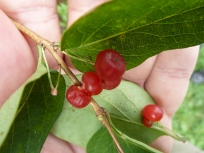
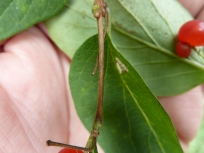
- Lonicera xylosteum (Dwarf Honeysuckle): Gray-green leaves, often obovate, but can
be ovate and oval. Upper leave is glaborous, lower leaf is hairy. Fruit is scarlet.
- Diervilla lonicera (Northern Bush-Honeysuckle): Finely-tooth leaves with
acuminate tips. Fruit is a capsule.
- Lonicera morrowii (Morrow’s Honeysuckle): Leaves very pubescent
(hairy) on the underside. Flower/fruit stalk (peduncle) is 5-15mm long. Leaf shape: oval.
Branchlets pubescent.
- Lonicera x bella (Bell’s Honeysuckle): Sparesely pubescent
branchlets and leaf blades (underside). Flower/fruit stalk (peduncle) is 5-15mm long.
- Lonicera tatarica (Tatarian Honeysuckle): Leaf blades and
branchlets glaborous (hairless). Flower/fruit stalk (peduncle) is 15-25mm long.
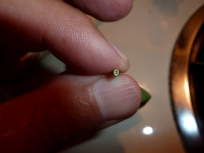
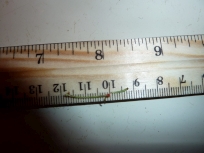 I even expanded the search to all Honeysuckles listed in the Maine, New Hampshire,
Vermont, Rhode Island and Massachusetts area:
I even expanded the search to all Honeysuckles listed in the Maine, New Hampshire,
Vermont, Rhode Island and Massachusetts area:
- Lonicera reticulata (Grape Honeysuckle): Leaves are sessile and uppermost
opposite leaves are perfoliate and rounded at the tip.
- Lonicera oblongifolia (Swamp Fly Honeysuckle): Leaves oblong -- long and
tapers at base and tip. Erect shrub growing up to 4-1/2 feet high. Leave hairy/downy
beneath.
- Lonicera maackii (Amur Honeysuckle): Leave are ovate and acuminate
(long tapering tip). Green above, paler and slighty hairy/fuzzy below.
- Lonicera hirsuta (Hairy Honeysuckle): Perennial trailing or climbing
deciduous vine. Upper leaf dark green and slightly hairy, lower surface is pale green
and hairy. Margins hairy. Cluster of two berries subtended by a pair of olive-colored,
saucer-shaped bracts.
- Lonicera periclymenum (European Honeysuckle): Deciduous, twining vine.
More than two berries grow together in large clumps.
August 8, 2011
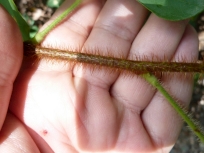
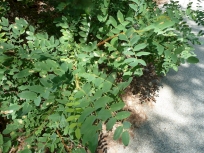 Look at the very long red hairs on the branches and even on the seed pods!
I did not find any thorns on the branches as I often do for the more hairless
and somewhat similar Black Locust (Robinia pseudoacacia).
Look at the very long red hairs on the branches and even on the seed pods!
I did not find any thorns on the branches as I often do for the more hairless
and somewhat similar Black Locust (Robinia pseudoacacia).
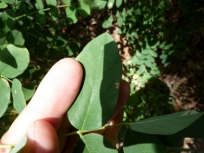
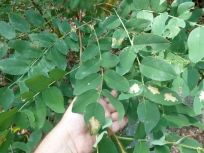 There are two other Robinia species in New Hampshire:
There are two other Robinia species in New Hampshire:
- Clammy Locust (Rose Acacia) (Robinia viscosa): Similar to Bristly Locust but
has the braches are covered with numerous, sticky short-stalked red glands and has a
pink-colored, pea-like flower.
- Black Locust (False Acacia) (Robinia pseudoacacia): Similar to
Bristly Locust but has no hairs or sticky red glands on the branches.
White, pea-like flowers.
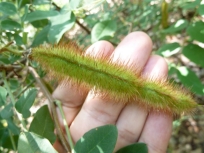
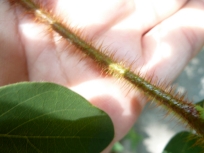
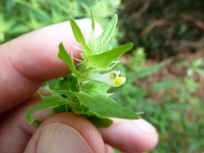
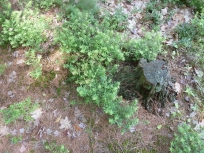
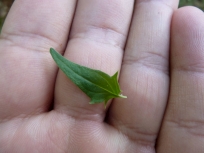
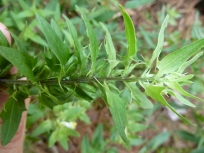
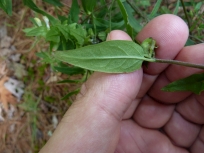
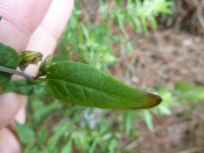
Here are some better quality pictures of the Narrowleaf Cow Wheat flower:
August 9, 2011
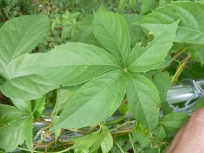
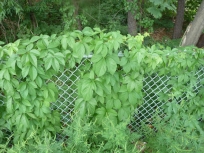
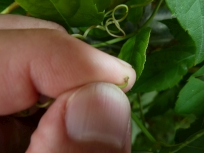
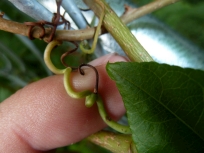
August 11-17, 2011
Visiting friends and family. Plant-related information: Travelled to Eastern Washington
State which is a desert region with sage, tumbleweed, Russian thistle and an amazing
amount of prickly lettuce. Then it was on to Minneapolis where the plants are very
similar to what is in Southern New Hampshire.
August 19, 2011
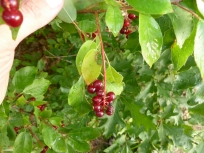
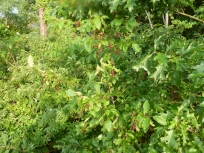
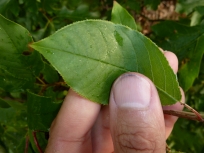
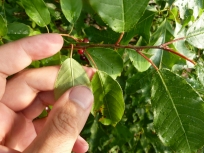
August 23, 2011
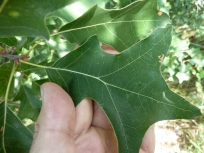
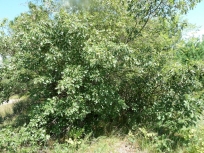
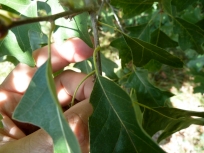
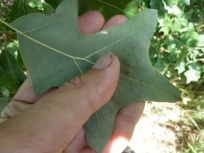
August 24, 2011
European Cranberrybush (Viburnum opulus var. opulus) (Synonym: Viburnum roseum)
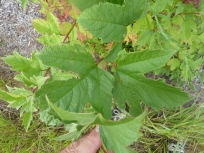
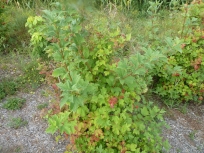 In New Hampshire, there are only a small number of Viburnums with lobed leaves:
In New Hampshire, there are only a small number of Viburnums with lobed leaves:
- American Cranberrybush (Viburnum opulus var. americanum)
- European Cranberrybush (Viburnum opulus var. opulus)
- Mapleleaf Viburnum (Viburnum acerifolium)
- Squashberry (Viburnum edule)
One of the most obvious differences is that Mapleleaf Viburnum and Squashberry
do not have the large, showy sterile flowers. They only have the smaller white flowers.
Also, Mapleleaf Viburnum does not have swollen glands on the leaf petioles. The
margins of Squashberry leaves have many teeth compared to the few teeth on the
leaf margins of Cranberrybush.
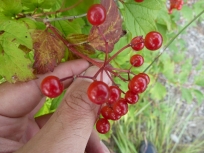
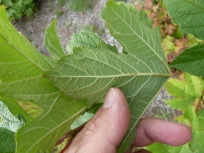 The Peterson Field Guide for Edible Plants says, ‘A European
ornamental occasionally escaped from cultivation,
V. opulus [Viburnum opulus var. opulus], is
almost a double for Highbush-cranberry, but with bitter fruit.”
For this reason, it is important to tell the two apart.
The Peterson Field Guide for Edible Plants says, ‘A European
ornamental occasionally escaped from cultivation,
V. opulus [Viburnum opulus var. opulus], is
almost a double for Highbush-cranberry, but with bitter fruit.”
For this reason, it is important to tell the two apart.
The following web page shows how to tell the two apart (using
a table and two links for pictures):
http://oregonstate.edu/dept/ldplants/vitr.htm. The American
Cranberrybush (var. americanum) has a wide and shallow groove on the leaf petiole,
small glands on the petiole and hairs only the leaf veins of the underside
of the leaf. The European Cranberrybush (var. opulus) has a thin groove
on the leaf petiole, larger, disk-shaped glands on the petiole and
often has hairs on the underside of the leaf in addition to the leaf vein hairs.
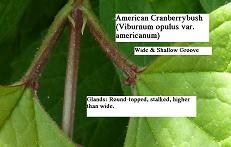
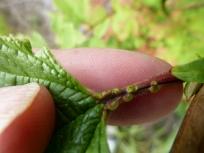 The book,
Manual of Vascular Plants of Northeastern United States and Adjacent Canada
points out that the glands on the petiole of American Cranberrybush (var.
americanum) are stalked, round-topped and mostly higher than wide. The glands
of the petiole of European Cranberrybush (var. opulus) are mostly sessile,
concave-topped and wider than high. Based on the third set of images from the top where
the one on the left is this plant and the one on the right is American
Cranberrybush (taken on May 30, 2011), this plant is clearly European Cranberrybush
(var. opulus).
The book,
Manual of Vascular Plants of Northeastern United States and Adjacent Canada
points out that the glands on the petiole of American Cranberrybush (var.
americanum) are stalked, round-topped and mostly higher than wide. The glands
of the petiole of European Cranberrybush (var. opulus) are mostly sessile,
concave-topped and wider than high. Based on the third set of images from the top where
the one on the left is this plant and the one on the right is American
Cranberrybush (taken on May 30, 2011), this plant is clearly European Cranberrybush
(var. opulus).
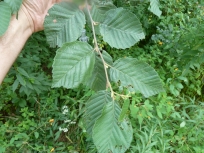
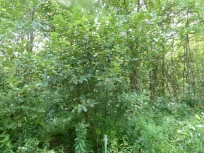 There are three alders in New Hampshire:
There are three alders in New Hampshire:
- Green Alder (Alnus viridis)
- Hazel Alder (Alnus serrulata)
- Speckled Alder (Alnus incana ssp. rugosa)
Green Alder has leaf buds that are pointed and have no stalk (sessile). As you can see
from the pictures in the table (below), these buds have a round top and have a short,
stubby stalk.
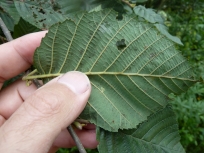
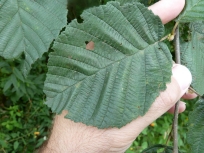 Hazel Alder does not have distinct whitish lenticels (pore-like aggregation of cells)
on the bark. As you can see from the pictures below, there are long whitish lenticels
on the bark.
Hazel Alder does not have distinct whitish lenticels (pore-like aggregation of cells)
on the bark. As you can see from the pictures below, there are long whitish lenticels
on the bark.
This leaves only Speckled Alder. Other features include the double-serrated
leaf margin, net-like venation on the back of the leaves, winged seeds in the
cones, orange colored pith, grows near swamps and streams.
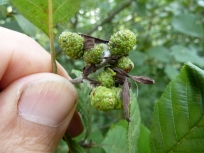
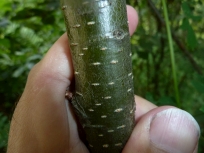
August 25, 2011
I had some difficulty with plant identification today. Some of the species
are so similar that it can be difficult to decide which is the right species.
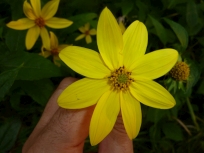
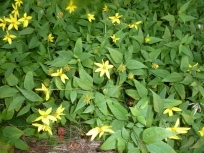 After nearly eight hours trying to identify this plant and thinking that it was
Smooth Beggarticks (Bidens laevis) for the first two hours, I’ve
settled on Thinleaf Sunflower (Helianthus decapetalus). Beggarticks species have
a prominent main vein in the leaf and no other prominent veins. Sunflower leaves are
“three-nerved,” meaning that they have three prominent veins (especially
near the base of the leaf).
After nearly eight hours trying to identify this plant and thinking that it was
Smooth Beggarticks (Bidens laevis) for the first two hours, I’ve
settled on Thinleaf Sunflower (Helianthus decapetalus). Beggarticks species have
a prominent main vein in the leaf and no other prominent veins. Sunflower leaves are
“three-nerved,” meaning that they have three prominent veins (especially
near the base of the leaf).
I went to the
Manual of Vascular Plants of Northeastern United States and Adjacent Canada,
but this plant does not perfectly match any of the descriptions. In the book, each
plant genus has a flowchart to help you decide on the species, but I discovered that the
flowcharts are not always accurate and that reading the species description is more
important. For example, the flowchart eventually gets to this species
(Helianthus decapetalus) as long as you decide that the disk in the center of
the flower is more than 1.5 cm wide. In many cases, however, the disk of this plant
is between 1 and 1.5 cm wide. Reading the description of helianthus decapetalus
leads one to discover that the disk can be 1-2 cm wide.
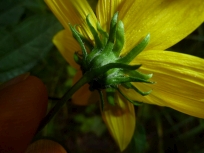
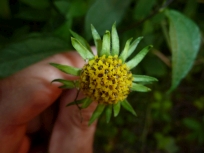 Below is a list of the other sunflowers found in New Hampshire and why they are not the
plant pictured:
Below is a list of the other sunflowers found in New Hampshire and why they are not the
plant pictured:
- Common Sunflower (Helianthus annus): Purple flower disk.
- Cucumberleaf Sunflower (Helianthus debilis): Purple flower disk. Oval leaves
with long petiole (leaf stem).
- Woodland Sunflower (Helianthus divaricatus): Sessile (no leaf stem) or
rarely a leaf stem up to 0.5 cm.
- Sawtooth Sunflower (Helianthus grosseserratus): Long leaves (10-20 cm)
that are more than 3 times long as wide. Lower leave surface green (not pale-green).
- Cheerful Sunflower (Helianthus x laetiflorus): Bracket leaves below
flower broad, firm and appressed. Very long petiole (up to 5 cm).
- Stiff Sunflower (Helianthus pauciflorus): Red/Purple flower disk.
- Jerusalem artichoke (Helianthus tuberosus): Leaves very large (10-25 cm long
and 4-12 cm wide), spreading-hairy stem.
- Paleleaf Woodland Sunflower (Helianthus strumosus): Green bract leaves
are not conspicuously ciliate (no conspicuously hairy margins). Very shallowly-toothed
leaves.
If you look closely at the flower head in the left most picture of the second row and
click on that picture to expand it (and click on it again to expand it more) you will
see that the flower head is actually made up of tiny 5-petal flowers!
Each floret in the flower head has a tiny bract (or chaff) called a
receptacular bract as can be seen in this drawing:
receptacular bracts. If you click on the very last image in the table below, you
will see that the bracts are yellowish-tipped, a fact which was important when I
thought this plant was Smooth Beggarticks and trying to differentiate it from
Nodding Beggarticks.
Thinleaf Sunflower grows up to 54 inches tall. It has yellow flowers with 8-15 petals
(1.5-3.5 cm long) and the central part of the flower is made up of numerous tiny flowers
each with five petals. Flowers are 4.5-9 cm wide and the central disk is 1-2 cm wide. The
leaves are opposite (but upper leaves can be alternate), have 1.5-6 cm petioles, broadly
lanceolate or ovate, serrated, 8-20 cm long by 3-8 cm wide, thin, scabrous (rough to touch),
pale green beneath and come to a sharp point (accuminate). Leaf base abruptly contracted
and decurrent (extends downwards to the petiole.
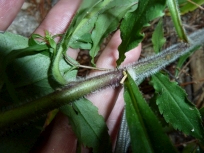
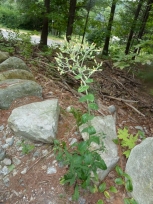 This Hawkweed was not as hard to identify as some plants. If you click on the rightmost
picture of the first row, you will notice long, spreading hairs on the plant stem.
The rightmost picture of the second row shows straight black hairs on the flower stem.
Also, notice in the last picture in the table below, you can see a close-up of the
gland-tipped hairs on the flower stem.
This Hawkweed was not as hard to identify as some plants. If you click on the rightmost
picture of the first row, you will notice long, spreading hairs on the plant stem.
The rightmost picture of the second row shows straight black hairs on the flower stem.
Also, notice in the last picture in the table below, you can see a close-up of the
gland-tipped hairs on the flower stem.
The flowers of this plant looked just like Hawkweed flowers. There are a handful
of Hawkweeds in New Hampshire that have leaves growing up the stem. Below is a
list and the reasons why this plant does not match a different Hawkweed:
- Allegheny Hawkweed (Hieracium paniculatum): Stem is mostly hairless.
Leaves are papery thin and narrowly elliptical. Flowers grow on thin, flexible stems
that tend to droop.
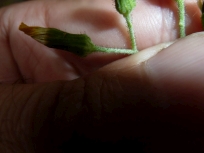
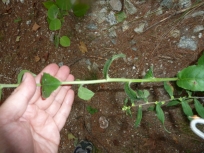
- Kalm’s Hawkweed (Canada Hawkweed) (Hieracium kalmii): Hairs on
peduncle (flower stalk) are not gland-tipped. (See last picture in table below).
- Common Hawkweed (Hieracium lachenalii): Mostly larger basal leaves
with 4-7 sessile stem leaves. 4-12 flowers in a round-topped cluster.
- Maryland Hawkweed (Hieracium marianum): Mostly basal leaves with
two to several stem leaves.
- Robinson’s Hawkweed (Hieracium robinsonii): Leaves with
slightly larger and more regular teeth that make is look a bit like a wide-leaved
Fall Dandelion (Leontodon autumnalis). White hairs on flower stem.
- Narrowleaf Hawkweed (Hieracium umbellatum): Narrowleaf Hawkweed has
a much thinner leaf width (up to 1-1/2 inches wide).
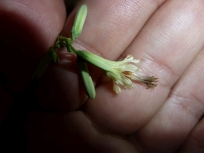
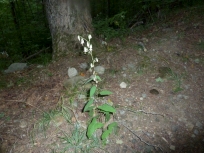 It is very difficult for me to tell the difference between Tall Rattlesnakeroot
(Prenanthes altissima) (this plant) and Gall of the Earth (Prenanthes
trifoliolata). The way that some tell the difference is to count the number of
primary bracts outside of the flower. If there are only five (5) primary
bracts, then it is Tall Rattlesnakeroot (Prenanthes altissima). Gall of the
Earth (Prenanthes trifoliolata) will have eight (8) or more primary bracts.
But here is the problem, what the %@!*!*@*(! is a primary bract?! There are very short
bracts at the base of the flower, but there are also bracts that run along the whole
length of the flower. In addition, some of these bracts overlap and some appear to
be partially or mostly beneath the other bracts. So I do not know how to tell exactly
which are primary bracts.
It is very difficult for me to tell the difference between Tall Rattlesnakeroot
(Prenanthes altissima) (this plant) and Gall of the Earth (Prenanthes
trifoliolata). The way that some tell the difference is to count the number of
primary bracts outside of the flower. If there are only five (5) primary
bracts, then it is Tall Rattlesnakeroot (Prenanthes altissima). Gall of the
Earth (Prenanthes trifoliolata) will have eight (8) or more primary bracts.
But here is the problem, what the %@!*!*@*(! is a primary bract?! There are very short
bracts at the base of the flower, but there are also bracts that run along the whole
length of the flower. In addition, some of these bracts overlap and some appear to
be partially or mostly beneath the other bracts. So I do not know how to tell exactly
which are primary bracts.

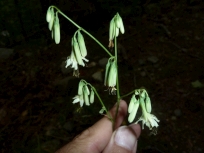 The book,
Manual of Vascular Plants of Northeastern United States and Adjacent Canada calls
these bracts, principal bracts and states that Gall of the Earth (Prenanthes
trifoliolata) will have 7-9 (usually 8) bracts and Tall Rattlesnakeroot
(Prenanthes altissima) will have 4-6 (usually 5) bracts. In addition, Gall of the
Earth will average 9-13 flowers in a loose panicle clusters while Tall Rattlesnakeroot
will have 5-6 flowers in a cluster (usually having some axillary clusters).
The book,
Manual of Vascular Plants of Northeastern United States and Adjacent Canada calls
these bracts, principal bracts and states that Gall of the Earth (Prenanthes
trifoliolata) will have 7-9 (usually 8) bracts and Tall Rattlesnakeroot
(Prenanthes altissima) will have 4-6 (usually 5) bracts. In addition, Gall of the
Earth will average 9-13 flowers in a loose panicle clusters while Tall Rattlesnakeroot
will have 5-6 flowers in a cluster (usually having some axillary clusters).
Update (9/5/2011): I was able to find Gall of the Earth (Prenanthes trifoliolata)
and pull apart an unopened flower to show that it had nine primary/principal bracts
and nine achenes with attached pappi. See the first image on the
September 5th
entry for Gall of the Earth for more information on differentiating these two
Prenanthes species.
Update 2 (9/14/2011): I took some pictures of a Tall Rattlesnakeroot (Tall White
Lettuce) (Prenanthes altissima) and was able to confirm that it was identified
correctly by counting the primary bracts. See the 2nd set of pictures dated 9/14/2011
at:
http://www.transformationalgardening.com/forage/plants/prenanthes-altissima-images.html#20110914.
August 26, 2011
Red Osier Dogwood (Cornus sericea) (Also known as: Swida sericea)
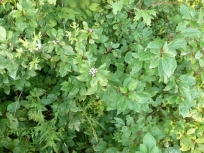
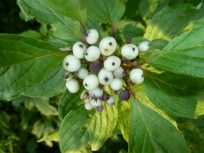 The other white fruited dogwood that looks similar is Gray Dogwood (Northern Swamp Dogwood)
(Cornus racemosa). It has 3-5 veins on each side of the midrib while Red Osier
Dogwood has 5-7 veins. Gray Dogwood has tan twigs and Red Osier Dogwood has bright red
twigs. Gray Dogwood leaves are cuneate (tapering to a point) at the base and Red Osier
Dogwood leaves are broadly-rounded or sometimes acute at the base.
The other white fruited dogwood that looks similar is Gray Dogwood (Northern Swamp Dogwood)
(Cornus racemosa). It has 3-5 veins on each side of the midrib while Red Osier
Dogwood has 5-7 veins. Gray Dogwood has tan twigs and Red Osier Dogwood has bright red
twigs. Gray Dogwood leaves are cuneate (tapering to a point) at the base and Red Osier
Dogwood leaves are broadly-rounded or sometimes acute at the base.
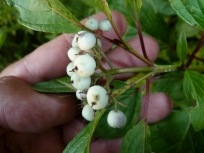
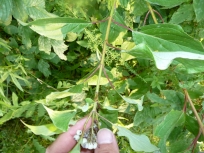
August 27, 2011
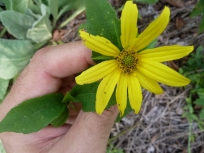
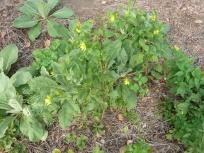 Below is a list of the other sunflowers found in New Hampshire and why they are not the
plant pictured:
Below is a list of the other sunflowers found in New Hampshire and why they are not the
plant pictured:
- Common Sunflower (Helianthus annus): Purple flower disk.
- Cucumberleaf Sunflower (Helianthus debilis): Purple flower disk. Oval leaves
with long petiole (leaf stem).
- Woodland Sunflower (Helianthus divaricatus): Sessile (no leaf stem) or
rarely a leaf stem up to 0.5 cm.
- Sawtooth Sunflower (Helianthus grosseserratus): Long leaves (10-20 cm)
that are more than 3 times long as wide. Lower leave surface green (not pale-green).
- Cheerful Sunflower (Helianthus x laetiflorus): Bracket leaves below
flower broad, firm and appressed. Very long petiole (up to 5 cm).
- Stiff Sunflower (Helianthus pauciflorus): Red/Purple flower disk.
- Jerusalem artichoke (Helianthus tuberosus): Leaves very large (10-25 cm long
and 4-12 cm wide), spreading-hairy stem.
- Thinleaf Sunflower (Helianthus decapetalus): Green bract leaves
are conspicuously ciliate (hairy margins). Significant serrated teeth on leaf margins.
leaves.
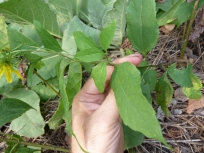
 Paleleaf Woodland Sunflower grows 36-72 inches tall. It has yellow flowers with 8-15
petals (1.5-4 cm long) and the central part of the flower is made up of numerous
tiny flowers each with five petals. Flowers are 5-9 cm wide and the central disk
is 1.2-2.5 cm wide. The leaves are opposite (but uppermost leaves can be alternate),
have 0.5-3 cm petioles, broadly lanceolate or ovate, serrated margin teeth, 8-20 cm
long by 2.5-10 cm wide, thin, scabrous (rough to touch) or hispid (short stiff hairs)
on upper side and moderately short-hairy and pale green below and leaf comes to a
sharp point (accuminate). Leaf base abruptly contracted and decurrent (extends
downwards to the petiole. Green bract leaves are conspicuously ciliate, having
long hairs on the margins.
Paleleaf Woodland Sunflower grows 36-72 inches tall. It has yellow flowers with 8-15
petals (1.5-4 cm long) and the central part of the flower is made up of numerous
tiny flowers each with five petals. Flowers are 5-9 cm wide and the central disk
is 1.2-2.5 cm wide. The leaves are opposite (but uppermost leaves can be alternate),
have 0.5-3 cm petioles, broadly lanceolate or ovate, serrated margin teeth, 8-20 cm
long by 2.5-10 cm wide, thin, scabrous (rough to touch) or hispid (short stiff hairs)
on upper side and moderately short-hairy and pale green below and leaf comes to a
sharp point (accuminate). Leaf base abruptly contracted and decurrent (extends
downwards to the petiole. Green bract leaves are conspicuously ciliate, having
long hairs on the margins.
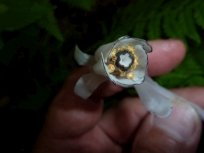
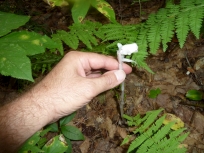 A perfect-looking specimen of Indian Pipe. I learned this Summer that Indian Pipe
is edible and if you get it early, the taste is more mild. Indian Pipe has a folk
use as an analgesic. Just be sure to that it is the white, single-flower
Monotropa uniflora and do not confused it with one with multiple colored
flowers, Pinesap (Monotropa hypopitys).
A perfect-looking specimen of Indian Pipe. I learned this Summer that Indian Pipe
is edible and if you get it early, the taste is more mild. Indian Pipe has a folk
use as an analgesic. Just be sure to that it is the white, single-flower
Monotropa uniflora and do not confused it with one with multiple colored
flowers, Pinesap (Monotropa hypopitys).
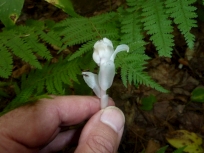
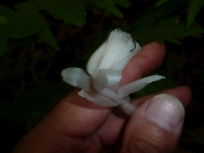
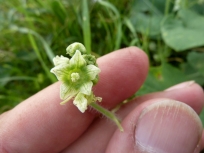
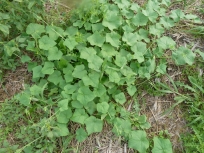
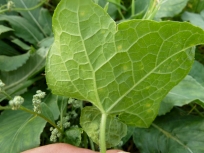
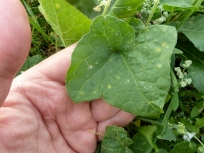
August 28, 2011
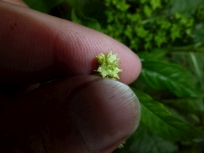
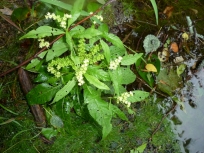 Fat-looking pale yellow flowers with five petals. I added a close-up of the
flower to the last picture in the table below. Leaves are alternate, sharply-toothed,
narrowly oval or narrowly elliptical. Plant can grow up to 28 inches tall. Notice how
the lower stem curves around for almost 12 inches before going underground.
Fat-looking pale yellow flowers with five petals. I added a close-up of the
flower to the last picture in the table below. Leaves are alternate, sharply-toothed,
narrowly oval or narrowly elliptical. Plant can grow up to 28 inches tall. Notice how
the lower stem curves around for almost 12 inches before going underground.
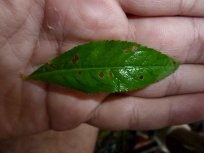
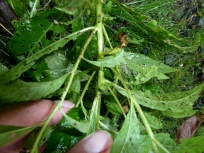
August 29, 2011
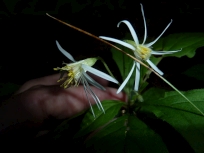
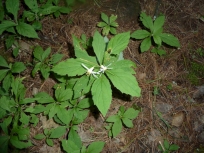
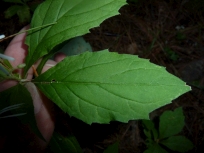
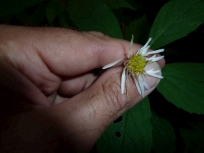
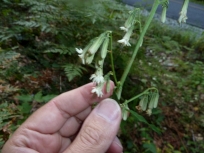
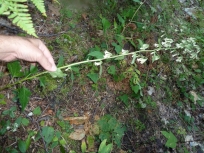 Update: I was able to find Gall of the Earth (Prenanthes trifoliolata)
and pull apart an unopened flower to show that it had nine primary/principal bracts
and nine achenes with attached pappi. See the first image on the
September 5th
entry for Gall of the Earth for more information on differentiating Gall of the Earth
and Tall Rattlesnakeroot (Prenanthes altissima).
Update: I was able to find Gall of the Earth (Prenanthes trifoliolata)
and pull apart an unopened flower to show that it had nine primary/principal bracts
and nine achenes with attached pappi. See the first image on the
September 5th
entry for Gall of the Earth for more information on differentiating Gall of the Earth
and Tall Rattlesnakeroot (Prenanthes altissima).
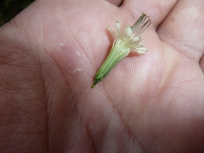
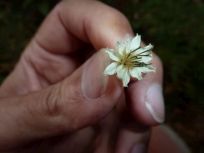
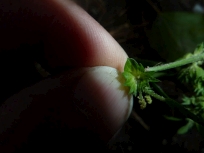
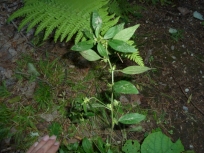
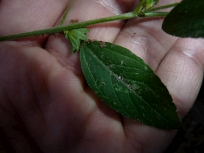
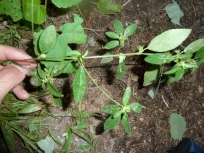
American Burnweed (Pilewort, Fireweed) (Erechtites hieraciifolia)
(Synonyms: Erechtites hieraciifolius, Erechtites hieracifolia)

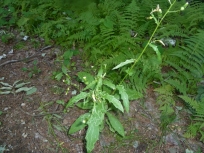
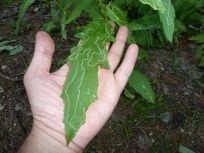
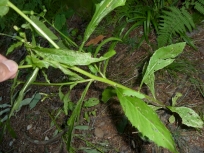
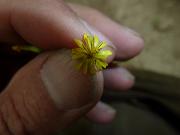
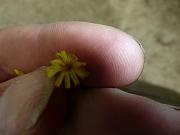
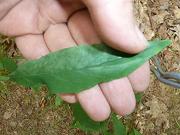
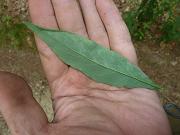
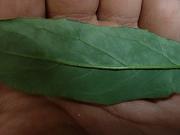
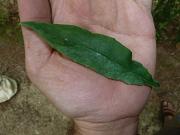
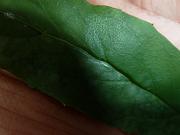
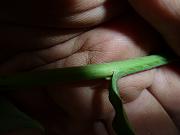
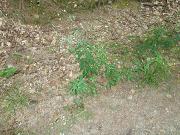
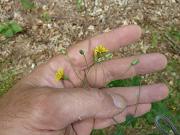
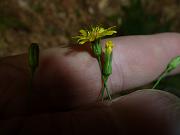

 The flowers of this plant looked just like Hawkweed flowers. There are a handful
of Hawkweeds in New Hampshire that have leaves growing up the stem:
The flowers of this plant looked just like Hawkweed flowers. There are a handful
of Hawkweeds in New Hampshire that have leaves growing up the stem:
 Narrowleaf Hawkweed has a thinner leaf width (up to 1-1/2 inches wide) and
the penduncles (flower stems) and plant stem have significant hairs. Rough
Hawkweed has a very bristly/hairy leaf margin, hairy stems and long
black hairs on the stem below the flowers. Robinson’s Hawkweed has leaves with
slightly larger and more regular teeth that make is look a bit like a wide-leaved
Fall Dandelion (Leontodon autumnalis). In addition, Robinson’s Hawkweed
has a hairy penduncle (not black hairs like Rough Hawkweed). Maryland Hawkweed
has mostly basal leaves with two to several stem leaves.
Narrowleaf Hawkweed has a thinner leaf width (up to 1-1/2 inches wide) and
the penduncles (flower stems) and plant stem have significant hairs. Rough
Hawkweed has a very bristly/hairy leaf margin, hairy stems and long
black hairs on the stem below the flowers. Robinson’s Hawkweed has leaves with
slightly larger and more regular teeth that make is look a bit like a wide-leaved
Fall Dandelion (Leontodon autumnalis). In addition, Robinson’s Hawkweed
has a hairy penduncle (not black hairs like Rough Hawkweed). Maryland Hawkweed
has mostly basal leaves with two to several stem leaves.














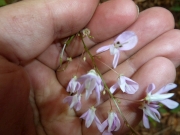
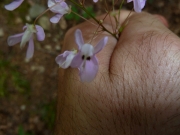
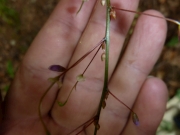
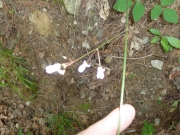
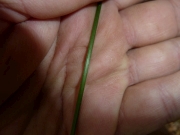
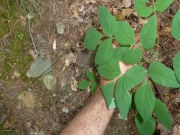
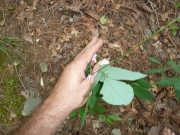
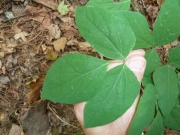
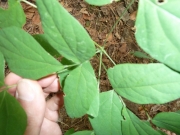
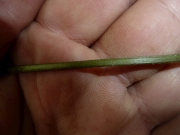





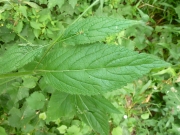
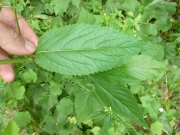
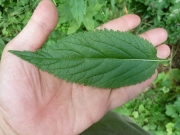
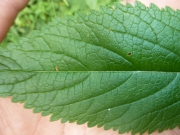
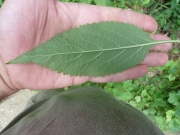
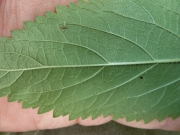
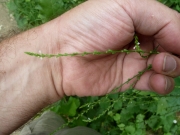
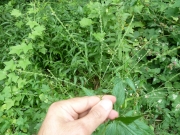
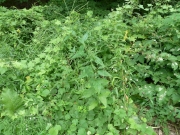

 In September, 2010 I found and took
pictures of Cardinalflower. But it was not a real “find” of the plant
since it was located at the Audobon Society and I believe it had been planted by
the staff. Today, however, I found it in the wild by going slightly off-trail
over some rocks next to a creek.
In September, 2010 I found and took
pictures of Cardinalflower. But it was not a real “find” of the plant
since it was located at the Audobon Society and I believe it had been planted by
the staff. Today, however, I found it in the wild by going slightly off-trail
over some rocks next to a creek.
 Cardinalflower is in the genus, Lobelia. Lobelia has been used for many
years by naturopaths to treat asthma, smoking addiction and externally to treat
muscle spasm. An overdose can cause nausea and vomiting, so it is best to rely
on the help of a professional herbalist or become knowledgable about proper dosing
when using Lobelia.
Cardinalflower is in the genus, Lobelia. Lobelia has been used for many
years by naturopaths to treat asthma, smoking addiction and externally to treat
muscle spasm. An overdose can cause nausea and vomiting, so it is best to rely
on the help of a professional herbalist or become knowledgable about proper dosing
when using Lobelia.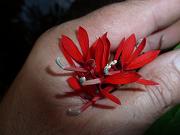
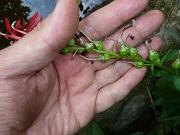
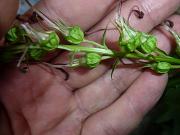
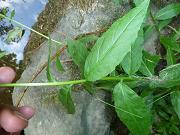
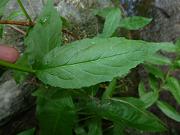
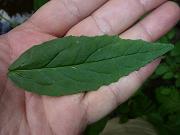
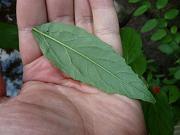
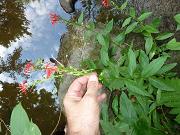
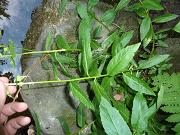
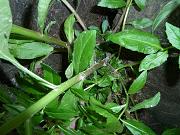
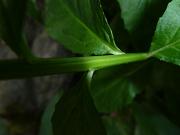

 Right across the main path from the Cardinalflower (Lobelia cardinalis)
I spotted American Witchhazel, a shrub I learned about in the recent
Healing with Plants, Fungi and Lichen class.
Right across the main path from the Cardinalflower (Lobelia cardinalis)
I spotted American Witchhazel, a shrub I learned about in the recent
Healing with Plants, Fungi and Lichen class.
 Tea can be made with the leaves (infusion) or the branchlets and inner bark (decoction).
It is valuable astringent. An ointment can be applied externally to treat
hemorrhoids. The tincture can be applied on sprains, bruises, wounds and the powder
mixed with honey and water can be applied to burns, abrasions and crushed toes and
fingers. The tea can be applied externally as well to treat sore muscles/backs, bruises,
swellings, cuts, insect bites, poison ivy, sunburn and varicose veins. Steam derived
from decocting stems can be used to treat sore muscles.
Tea can be made with the leaves (infusion) or the branchlets and inner bark (decoction).
It is valuable astringent. An ointment can be applied externally to treat
hemorrhoids. The tincture can be applied on sprains, bruises, wounds and the powder
mixed with honey and water can be applied to burns, abrasions and crushed toes and
fingers. The tea can be applied externally as well to treat sore muscles/backs, bruises,
swellings, cuts, insect bites, poison ivy, sunburn and varicose veins. Steam derived
from decocting stems can be used to treat sore muscles.
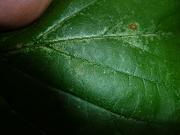
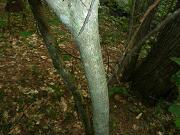
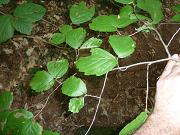
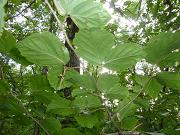
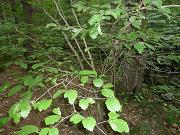
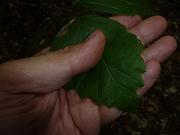
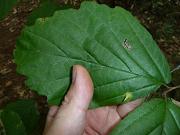


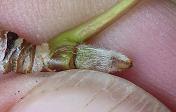
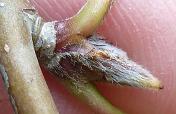
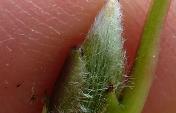
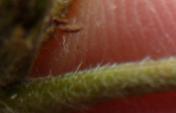


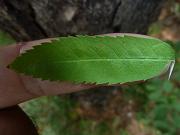
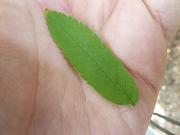
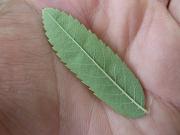
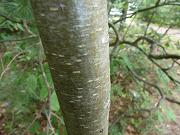
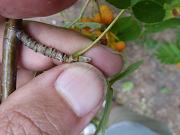
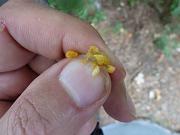
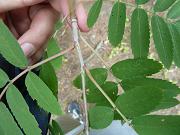
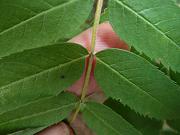
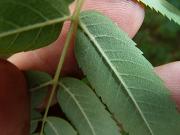
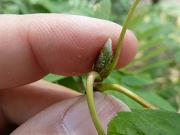

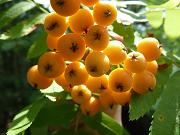
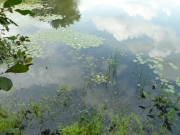
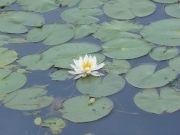
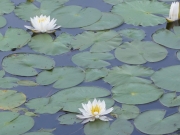

 I may not ever be able to easily differentiate the honeysuckles. I will call
this Tatarian Honeysuckle even though I’m not 100% certain. The pictures
fit most of the description of Tatarian Honeysuckle such as glaborous (hairless)
underside of leaves and branchlets. The peduncles (flower/fruit stalks) are
15-25mm long. Dense and twiggy shrub. Pith is white. The only problem is that the
field guides say the leaves are up to 6.5cm long, but some of these leaves are
7.5cm long. Still it does not seem to even come close to fitting the description
of any other Honeysuckles in the area. The following are the Honeysuckles that grow
in New Hampshire and the reason (if any) that this plant is different:
I may not ever be able to easily differentiate the honeysuckles. I will call
this Tatarian Honeysuckle even though I’m not 100% certain. The pictures
fit most of the description of Tatarian Honeysuckle such as glaborous (hairless)
underside of leaves and branchlets. The peduncles (flower/fruit stalks) are
15-25mm long. Dense and twiggy shrub. Pith is white. The only problem is that the
field guides say the leaves are up to 6.5cm long, but some of these leaves are
7.5cm long. Still it does not seem to even come close to fitting the description
of any other Honeysuckles in the area. The following are the Honeysuckles that grow
in New Hampshire and the reason (if any) that this plant is different:





 I even expanded the search to all Honeysuckles listed in the Maine, New Hampshire,
Vermont, Rhode Island and Massachusetts area:
I even expanded the search to all Honeysuckles listed in the Maine, New Hampshire,
Vermont, Rhode Island and Massachusetts area: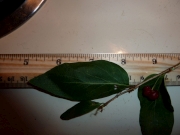
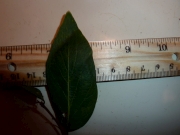
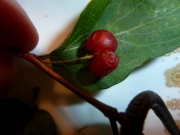
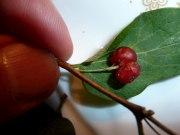
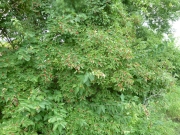

 Look at the very long red hairs on the branches and even on the seed pods!
I did not find any thorns on the branches as I often do for the more hairless
and somewhat similar Black Locust (Robinia pseudoacacia).
Look at the very long red hairs on the branches and even on the seed pods!
I did not find any thorns on the branches as I often do for the more hairless
and somewhat similar Black Locust (Robinia pseudoacacia).
 There are two other Robinia species in New Hampshire:
There are two other Robinia species in New Hampshire:

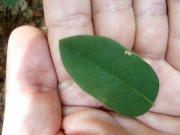
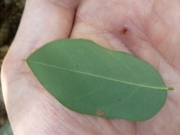
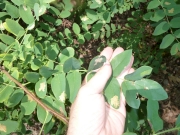
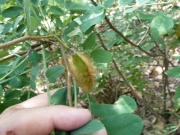
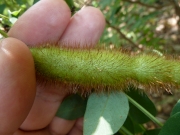
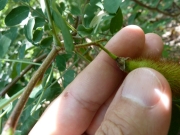
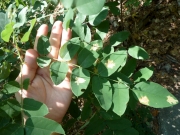
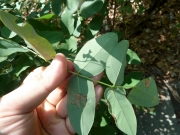
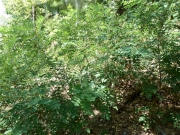
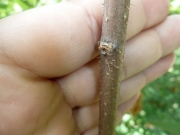
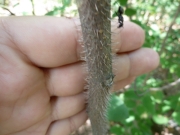
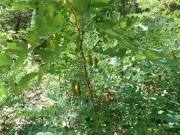






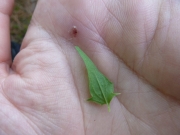
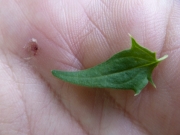
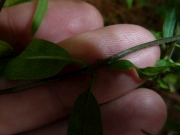
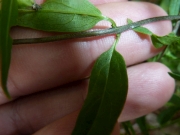
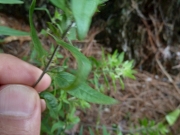
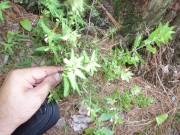
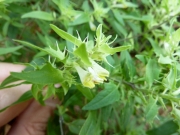
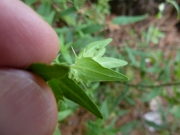

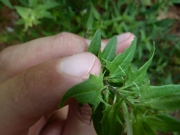
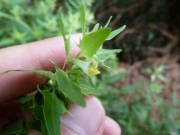
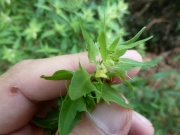
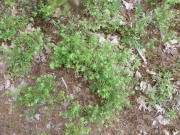
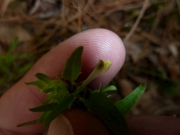
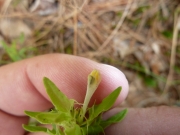
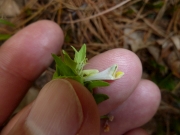
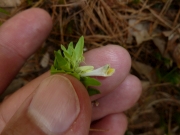
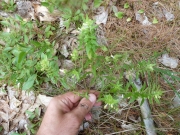
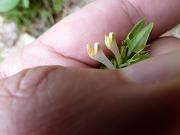




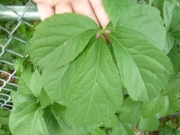
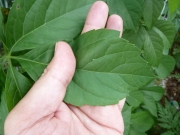
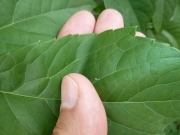

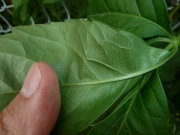
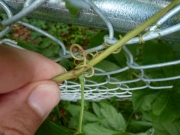
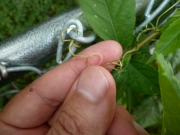
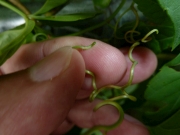
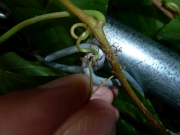
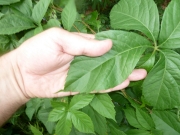
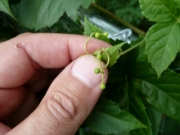




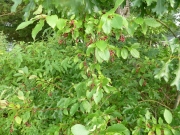
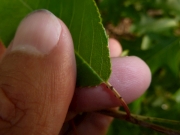
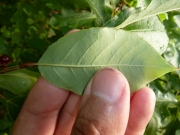
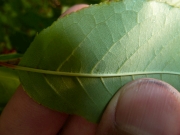
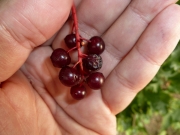
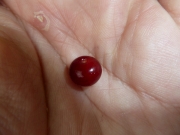
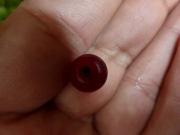
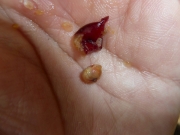
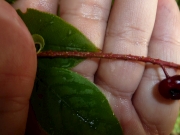
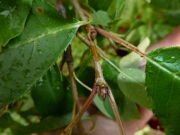
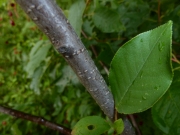
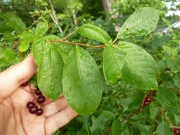




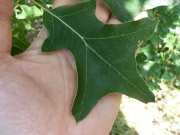
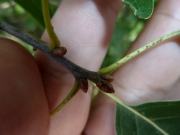
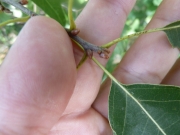

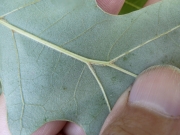

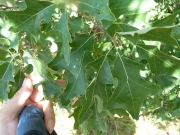
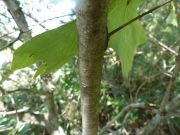
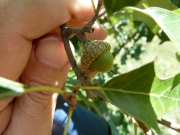
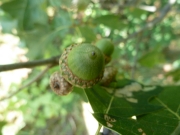

 In New Hampshire, there are only a small number of Viburnums with lobed leaves:
In New Hampshire, there are only a small number of Viburnums with lobed leaves:
 The Peterson Field Guide for Edible Plants says, ‘A European
ornamental occasionally escaped from cultivation,
V. opulus [Viburnum opulus var. opulus], is
almost a double for Highbush-cranberry, but with bitter fruit.”
For this reason, it is important to tell the two apart.
The Peterson Field Guide for Edible Plants says, ‘A European
ornamental occasionally escaped from cultivation,
V. opulus [Viburnum opulus var. opulus], is
almost a double for Highbush-cranberry, but with bitter fruit.”
For this reason, it is important to tell the two apart.
 The book,
Manual of Vascular Plants of Northeastern United States and Adjacent Canada
points out that the glands on the petiole of American Cranberrybush (var.
americanum) are stalked, round-topped and mostly higher than wide. The glands
of the petiole of European Cranberrybush (var. opulus) are mostly sessile,
concave-topped and wider than high. Based on the third set of images from the top where
the one on the left is this plant and the one on the right is American
Cranberrybush (taken on May 30, 2011), this plant is clearly European Cranberrybush
(var. opulus).
The book,
Manual of Vascular Plants of Northeastern United States and Adjacent Canada
points out that the glands on the petiole of American Cranberrybush (var.
americanum) are stalked, round-topped and mostly higher than wide. The glands
of the petiole of European Cranberrybush (var. opulus) are mostly sessile,
concave-topped and wider than high. Based on the third set of images from the top where
the one on the left is this plant and the one on the right is American
Cranberrybush (taken on May 30, 2011), this plant is clearly European Cranberrybush
(var. opulus).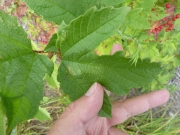
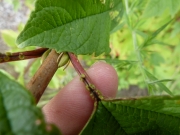
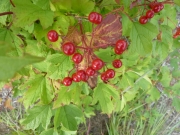
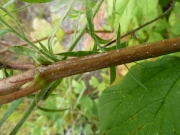
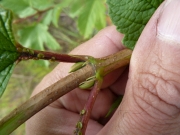
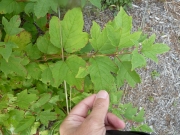
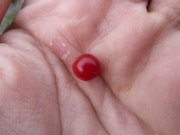
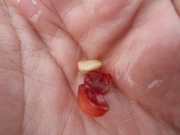

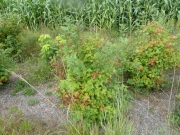

 There are three alders in New Hampshire:
There are three alders in New Hampshire:
 Hazel Alder does not have distinct whitish lenticels (pore-like aggregation of cells)
on the bark. As you can see from the pictures below, there are long whitish lenticels
on the bark.
Hazel Alder does not have distinct whitish lenticels (pore-like aggregation of cells)
on the bark. As you can see from the pictures below, there are long whitish lenticels
on the bark.

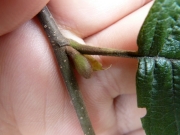
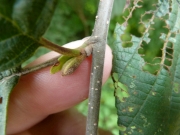
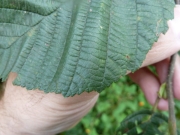
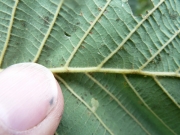
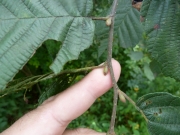
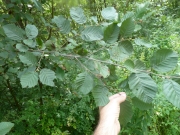
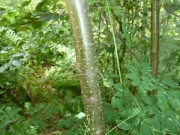
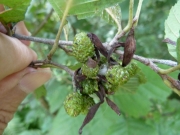
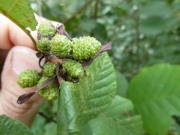
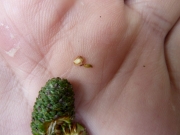
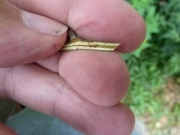
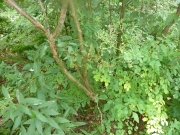

 After nearly eight hours trying to identify this plant and thinking that it was
Smooth Beggarticks (Bidens laevis) for the first two hours, I’ve
settled on Thinleaf Sunflower (Helianthus decapetalus). Beggarticks species have
a prominent main vein in the leaf and no other prominent veins. Sunflower leaves are
“three-nerved,” meaning that they have three prominent veins (especially
near the base of the leaf).
After nearly eight hours trying to identify this plant and thinking that it was
Smooth Beggarticks (Bidens laevis) for the first two hours, I’ve
settled on Thinleaf Sunflower (Helianthus decapetalus). Beggarticks species have
a prominent main vein in the leaf and no other prominent veins. Sunflower leaves are
“three-nerved,” meaning that they have three prominent veins (especially
near the base of the leaf).
 Below is a list of the other sunflowers found in New Hampshire and why they are not the
plant pictured:
Below is a list of the other sunflowers found in New Hampshire and why they are not the
plant pictured: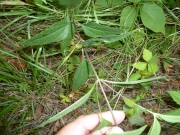
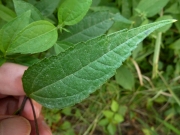
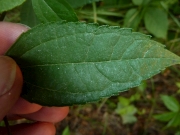
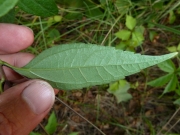
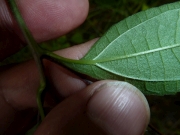
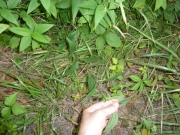
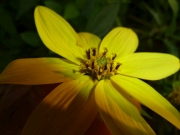
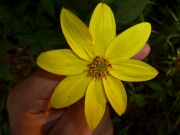
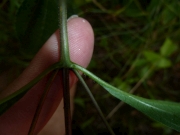
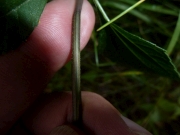
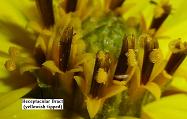

 This Hawkweed was not as hard to identify as some plants. If you click on the rightmost
picture of the first row, you will notice long, spreading hairs on the plant stem.
The rightmost picture of the second row shows straight black hairs on the flower stem.
Also, notice in the last picture in the table below, you can see a close-up of the
gland-tipped hairs on the flower stem.
This Hawkweed was not as hard to identify as some plants. If you click on the rightmost
picture of the first row, you will notice long, spreading hairs on the plant stem.
The rightmost picture of the second row shows straight black hairs on the flower stem.
Also, notice in the last picture in the table below, you can see a close-up of the
gland-tipped hairs on the flower stem.

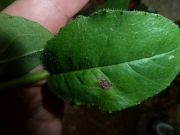
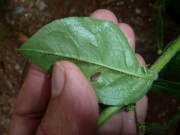
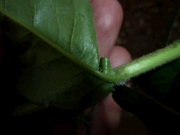
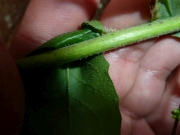
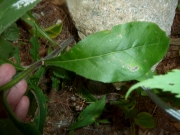
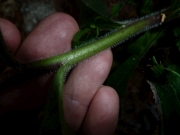
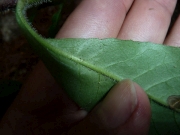
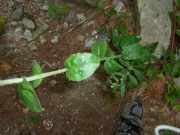
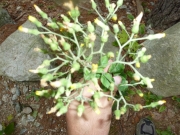
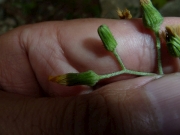
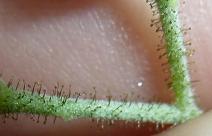

 It is very difficult for me to tell the difference between Tall Rattlesnakeroot
(Prenanthes altissima) (this plant) and Gall of the Earth (Prenanthes
trifoliolata). The way that some tell the difference is to count the number of
primary bracts outside of the flower. If there are only five (5) primary
bracts, then it is Tall Rattlesnakeroot (Prenanthes altissima). Gall of the
Earth (Prenanthes trifoliolata) will have eight (8) or more primary bracts.
But here is the problem, what the %@!*!*@*(! is a primary bract?! There are very short
bracts at the base of the flower, but there are also bracts that run along the whole
length of the flower. In addition, some of these bracts overlap and some appear to
be partially or mostly beneath the other bracts. So I do not know how to tell exactly
which are primary bracts.
It is very difficult for me to tell the difference between Tall Rattlesnakeroot
(Prenanthes altissima) (this plant) and Gall of the Earth (Prenanthes
trifoliolata). The way that some tell the difference is to count the number of
primary bracts outside of the flower. If there are only five (5) primary
bracts, then it is Tall Rattlesnakeroot (Prenanthes altissima). Gall of the
Earth (Prenanthes trifoliolata) will have eight (8) or more primary bracts.
But here is the problem, what the %@!*!*@*(! is a primary bract?! There are very short
bracts at the base of the flower, but there are also bracts that run along the whole
length of the flower. In addition, some of these bracts overlap and some appear to
be partially or mostly beneath the other bracts. So I do not know how to tell exactly
which are primary bracts.
 The book,
Manual of Vascular Plants of Northeastern United States and Adjacent Canada calls
these bracts, principal bracts and states that Gall of the Earth (Prenanthes
trifoliolata) will have 7-9 (usually 8) bracts and Tall Rattlesnakeroot
(Prenanthes altissima) will have 4-6 (usually 5) bracts. In addition, Gall of the
Earth will average 9-13 flowers in a loose panicle clusters while Tall Rattlesnakeroot
will have 5-6 flowers in a cluster (usually having some axillary clusters).
The book,
Manual of Vascular Plants of Northeastern United States and Adjacent Canada calls
these bracts, principal bracts and states that Gall of the Earth (Prenanthes
trifoliolata) will have 7-9 (usually 8) bracts and Tall Rattlesnakeroot
(Prenanthes altissima) will have 4-6 (usually 5) bracts. In addition, Gall of the
Earth will average 9-13 flowers in a loose panicle clusters while Tall Rattlesnakeroot
will have 5-6 flowers in a cluster (usually having some axillary clusters).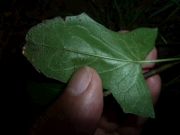
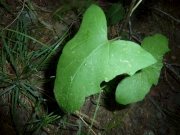
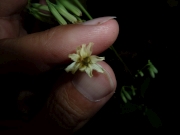

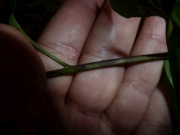
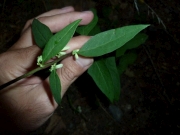
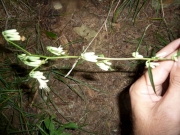
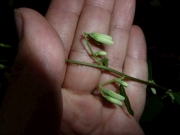

 The other white fruited dogwood that looks similar is Gray Dogwood (Northern Swamp Dogwood)
(Cornus racemosa). It has 3-5 veins on each side of the midrib while Red Osier
Dogwood has 5-7 veins. Gray Dogwood has tan twigs and Red Osier Dogwood has bright red
twigs. Gray Dogwood leaves are cuneate (tapering to a point) at the base and Red Osier
Dogwood leaves are broadly-rounded or sometimes acute at the base.
The other white fruited dogwood that looks similar is Gray Dogwood (Northern Swamp Dogwood)
(Cornus racemosa). It has 3-5 veins on each side of the midrib while Red Osier
Dogwood has 5-7 veins. Gray Dogwood has tan twigs and Red Osier Dogwood has bright red
twigs. Gray Dogwood leaves are cuneate (tapering to a point) at the base and Red Osier
Dogwood leaves are broadly-rounded or sometimes acute at the base.

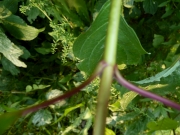
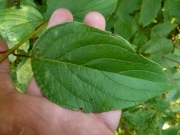
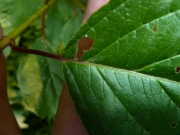
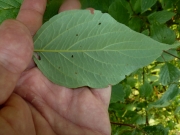
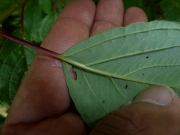
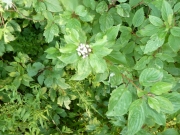
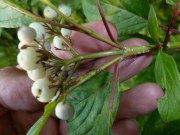
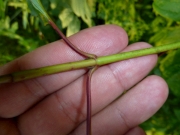
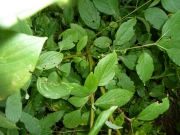
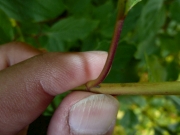
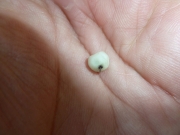
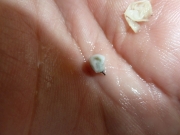

 Below is a list of the other sunflowers found in New Hampshire and why they are not the
plant pictured:
Below is a list of the other sunflowers found in New Hampshire and why they are not the
plant pictured:
 Paleleaf Woodland Sunflower grows 36-72 inches tall. It has yellow flowers with 8-15
petals (1.5-4 cm long) and the central part of the flower is made up of numerous
tiny flowers each with five petals. Flowers are 5-9 cm wide and the central disk
is 1.2-2.5 cm wide. The leaves are opposite (but uppermost leaves can be alternate),
have 0.5-3 cm petioles, broadly lanceolate or ovate, serrated margin teeth, 8-20 cm
long by 2.5-10 cm wide, thin, scabrous (rough to touch) or hispid (short stiff hairs)
on upper side and moderately short-hairy and pale green below and leaf comes to a
sharp point (accuminate). Leaf base abruptly contracted and decurrent (extends
downwards to the petiole. Green bract leaves are conspicuously ciliate, having
long hairs on the margins.
Paleleaf Woodland Sunflower grows 36-72 inches tall. It has yellow flowers with 8-15
petals (1.5-4 cm long) and the central part of the flower is made up of numerous
tiny flowers each with five petals. Flowers are 5-9 cm wide and the central disk
is 1.2-2.5 cm wide. The leaves are opposite (but uppermost leaves can be alternate),
have 0.5-3 cm petioles, broadly lanceolate or ovate, serrated margin teeth, 8-20 cm
long by 2.5-10 cm wide, thin, scabrous (rough to touch) or hispid (short stiff hairs)
on upper side and moderately short-hairy and pale green below and leaf comes to a
sharp point (accuminate). Leaf base abruptly contracted and decurrent (extends
downwards to the petiole. Green bract leaves are conspicuously ciliate, having
long hairs on the margins.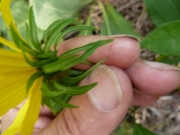
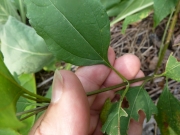
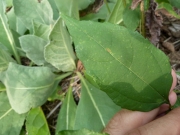
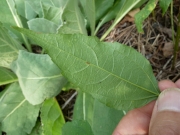
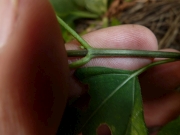

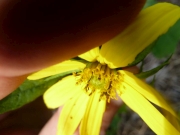
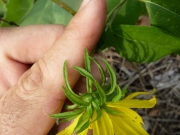
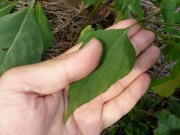
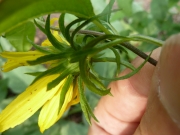
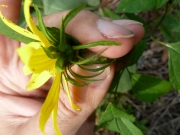

 A perfect-looking specimen of Indian Pipe. I learned this Summer that Indian Pipe
is edible and if you get it early, the taste is more mild. Indian Pipe has a folk
use as an analgesic. Just be sure to that it is the white, single-flower
Monotropa uniflora and do not confused it with one with multiple colored
flowers, Pinesap (Monotropa hypopitys).
A perfect-looking specimen of Indian Pipe. I learned this Summer that Indian Pipe
is edible and if you get it early, the taste is more mild. Indian Pipe has a folk
use as an analgesic. Just be sure to that it is the white, single-flower
Monotropa uniflora and do not confused it with one with multiple colored
flowers, Pinesap (Monotropa hypopitys).


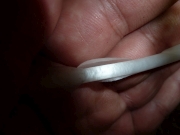
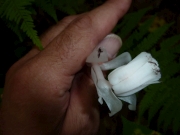
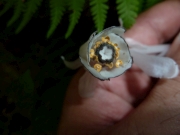
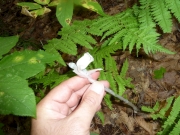




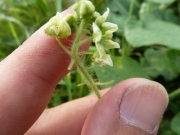
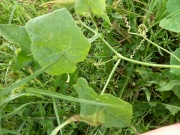

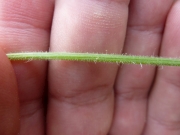
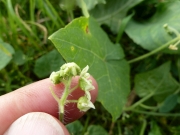
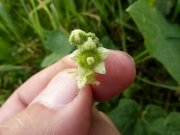
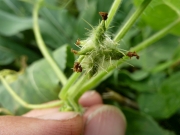
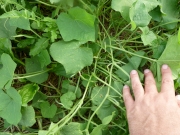
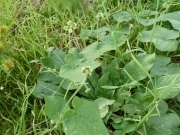
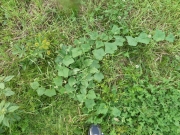

 Fat-looking pale yellow flowers with five petals. I added a close-up of the
flower to the last picture in the table below. Leaves are alternate, sharply-toothed,
narrowly oval or narrowly elliptical. Plant can grow up to 28 inches tall. Notice how
the lower stem curves around for almost 12 inches before going underground.
Fat-looking pale yellow flowers with five petals. I added a close-up of the
flower to the last picture in the table below. Leaves are alternate, sharply-toothed,
narrowly oval or narrowly elliptical. Plant can grow up to 28 inches tall. Notice how
the lower stem curves around for almost 12 inches before going underground.

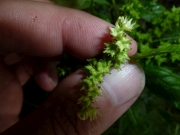
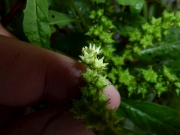
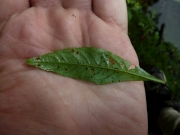
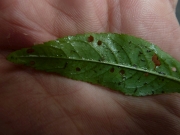
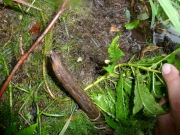
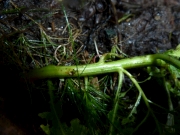

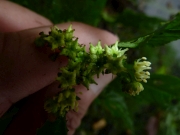
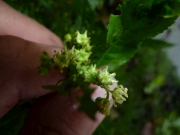
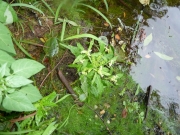
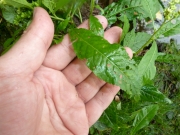
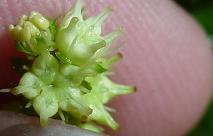




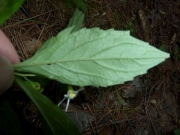
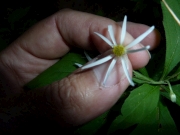
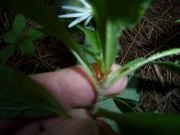
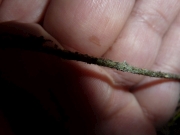
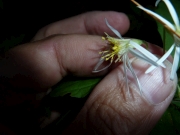
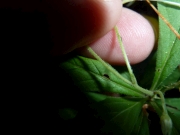
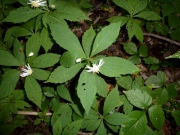
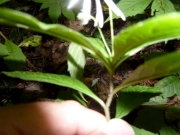
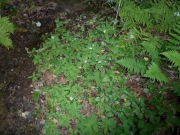

 Update: I was able to find Gall of the Earth (Prenanthes trifoliolata)
and pull apart an unopened flower to show that it had nine primary/principal bracts
and nine achenes with attached pappi. See the first image on the
September 5th
entry for Gall of the Earth for more information on differentiating Gall of the Earth
and Tall Rattlesnakeroot (Prenanthes altissima).
Update: I was able to find Gall of the Earth (Prenanthes trifoliolata)
and pull apart an unopened flower to show that it had nine primary/principal bracts
and nine achenes with attached pappi. See the first image on the
September 5th
entry for Gall of the Earth for more information on differentiating Gall of the Earth
and Tall Rattlesnakeroot (Prenanthes altissima).


